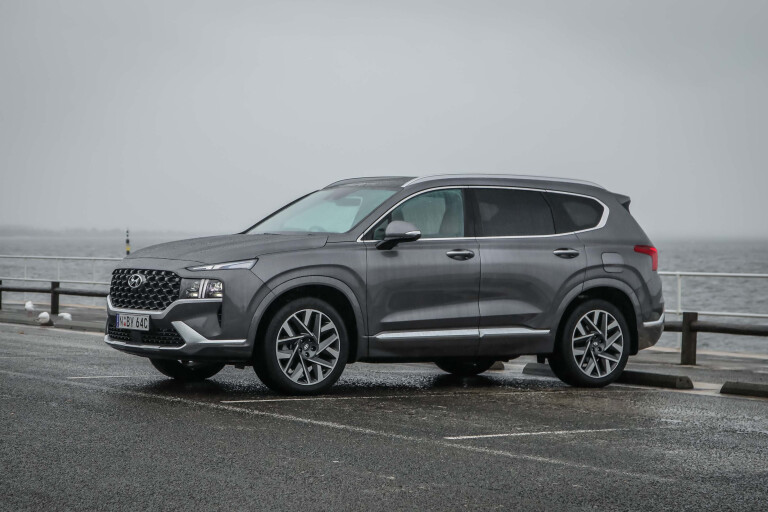
Score breakdown
Things we like
- Excellent driveline
- Loaded with tech and gear
- Much better than the petrol
- So comfortable
Not so much
- Hybrid option might be better
- Tight third row
- No wireless Apple CarPlay
- Curtain airbags don’t reach third row
One thing you can count on in the modern automotive market is the rate at which carmakers make changes to their most popular machines to keep pace with the ever-changing market. A case in point is the Hyundai Santa Fe; you can tell what’s doing well – or could do better – by the number of tweaks and changes with each passing year.
Hyundai has made yet another reasonably interesting update to the Santa Fe large SUV in the form of safety tweaks, partly to keep up with the competition and partly to keep up with ANCAP’s ever-evolving stance on five-star ratings.
We already know the Santa Fe is an excellent machine and particularly so in the Highlander diesel variant. Except that could be under threat later in the year with the hybrid Santa Fe finally making its way here.
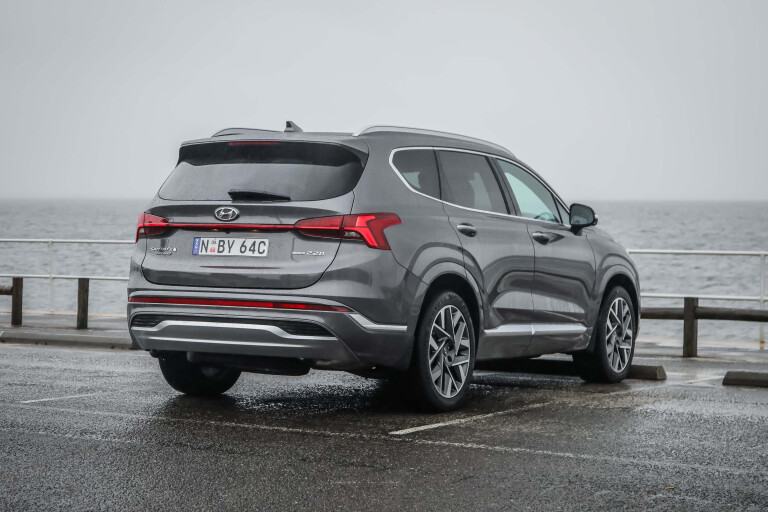
Pricing and features
The MY22 Santa Fe has seen that scourge of the car buyer hit with some force – the price rise. Whereas a few short months ago you could purchase a Highlander diesel for $65,200, you’re now looking at $66,050 before on-road costs, although the absolutely-worth-it upgrade away from the front-wheel-drive V6 petrol is still $3500.
It’s always annoying when prices go up, but it’s for a good cause – safety – which I’ll cover in a bit.
Anyway, to kick off you get 20-inch alloy wheels, the bigger 10.25-inch touchscreen, 12.3-inch digital dashboard, 10-speaker audio, sat-nav, power-adjustable front seats with heating and cooling, heated rear outboard seats, wireless phone charger, keyless entry and start, front and rear parking sensors, adaptive cruise control, power tailgate, panoramic sunroof, auto LED headlights, rain-sensing wipers and a full-size spare wheel.
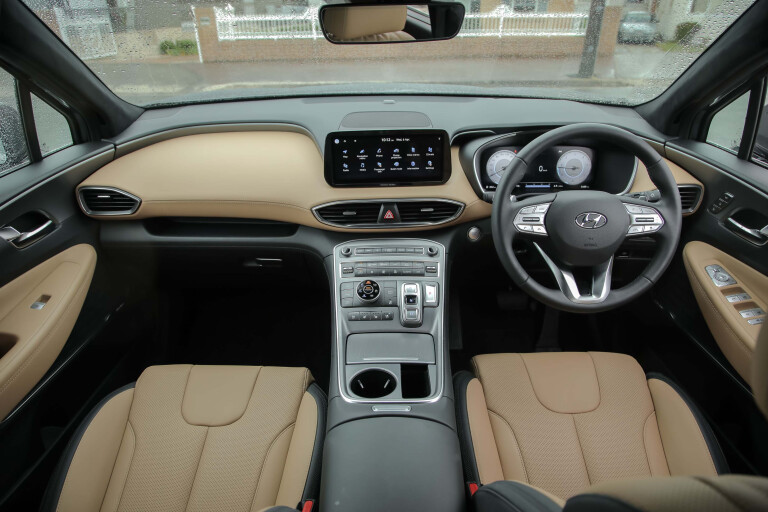
The big media screen features Hyundai's (and Kia’s) very useful home-grown software full of both diverting and useful features, including the always-amusing ASMR audio feature called Sounds of Nature (including, for some reason, a noisy cafe) and the intercom to the third row. You also get Apple CarPlay and Android Auto in full widescreen glory.
You also get the remarkably useful remote control parking feature where you can roll the car forward and back using the key, particularly useful in tight parking spaces such as one I used to frequent in a dingy Sydney CBD basement (because it was cheap before you all start sniggering).
The centre airbag and multi-collision braking – where the car will automatically jam on the brakes after the airbags blow – are both standard across the entire MY22 range, which is welcome news.
On the safety front, you now get a seventh airbag (a new front centre airbag to avoid head clashes), ABS, stability and traction controls, forward auto emergency braking (10-65km/h for pedestrians and cyclists, 75km/h for cars), turn assist, rear cross-traffic alert, rear AEB, lane-keep assist and blind-spot monitoring.
The centre airbag and multi-collision braking – where the car will automatically jam on the brakes if you don’t after the airbags blow – are both standard across the entire MY22 range, which is welcome news. Less welcome is that the curtain airbags still don’t reach the third row.

Comfort and space
This Santa Fe’s cabin – first seen in 2018 – got a mid-life refresh seemingly twenty minutes after it was released (the pandemic has had a curious effect on my perception of time) in which some variants – including the Highlander – scored the flying console design.
It’s a bit of good and a bit of bad. The bad is a ton of buttons that take a while to learn, while the good is the enormous storage area between the seats on the floor underneath.
It is stylish, however, and everything is easy to use even if you need the hippocampus of a London cabbie. Or a Porsche owner (because Porsches have lots of buttons, you see).
The front seats are heated and ventilated and plush and comfortable and honestly, I nearly took the laptop out to work in this car during the week I had it. They seem too cushy to be supportive but it’s because the leather is surprisingly soft to the touch.
Yes, I know I’m sounding weird here, but ya gotta try to understand. The incredibly frustrating drive home on the day I collected this car was made much more bearable by these seats.
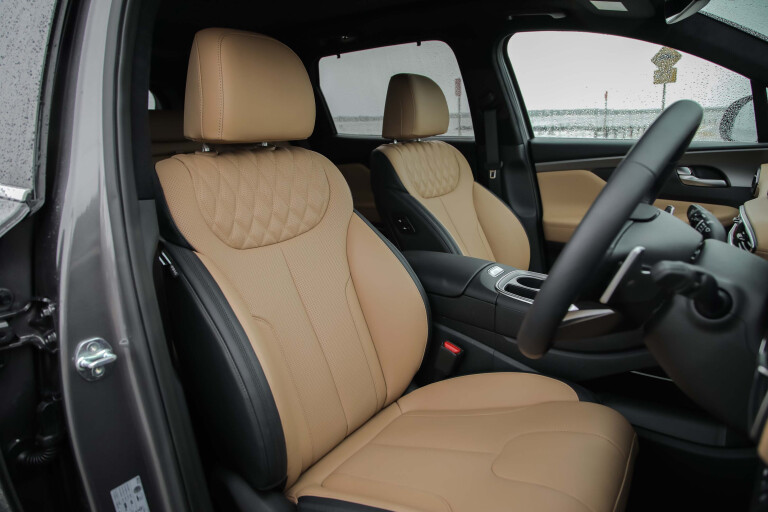
The incredibly frustrating drive home on the day I collected this car was made much more bearable by these seats.
For storage, there are two cup holders, a console bin and two bottle holders in the doors. There is also a spring-loaded slot for your phone that doubles as a wireless charging pad. It's just a pity you have to string a USB cable from the base of the centre stack to make the CarPlay/Auto connection work. You have two of those, one USB-A and one USB-C.
The middle row is also uncommonly comfortable, the window seats featuring actual shape rather than being a flat bench and you have heating, too, as well as air vents and your own climate control zone.
Two USB ports supply charging and sun-shades in the side windows cut glare. The centre row can also slide forward towards the front seats for easier access/admonishment opportunities while also liberating more space for the third row.
Third-row dwellers score reasonably comfortable seats, USB ports, cup holders and little trays for small devices or whatever it is kids eat in cars now; I’m guessing it's not jubes. Access is fair, with a lever on the middle row dropping the backrest forward and sliding the seat sort of out of the way.
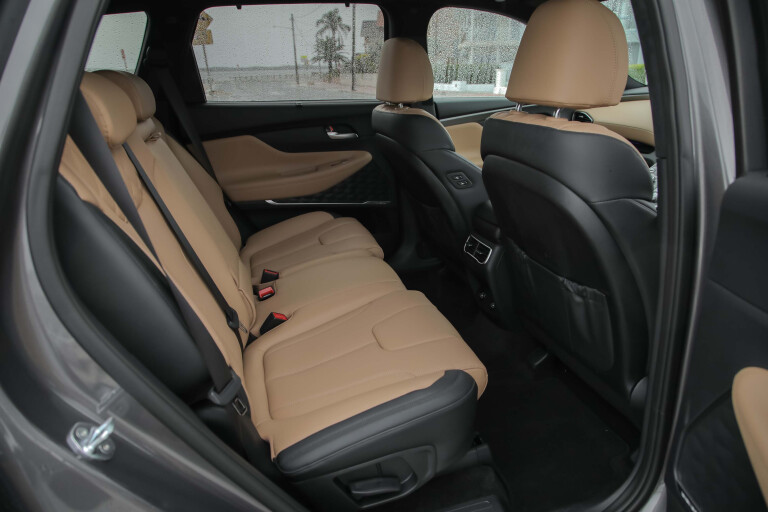
And just to repeat, the curtain airbag protection does not extend to the final row.
Boot space is impressive, starting at 130 litres with all seats in place. Push the third row down and you have between 571 and 782 litres depending on where you leave the middle row.
Hyundai still doesn’t offer an all-seats-down figure, but it’s probably closing in on 1600 litres. You could easily bunk in for the night, obviously to watch the stars through the giant sunroof.
Towing capacity is rated at 2500kg for a braked trailer, 750 unbraked and a maximum tow ball load of 200kg.
You could easily bunk in for the night, obviously to watch the stars through the giant sunroof.
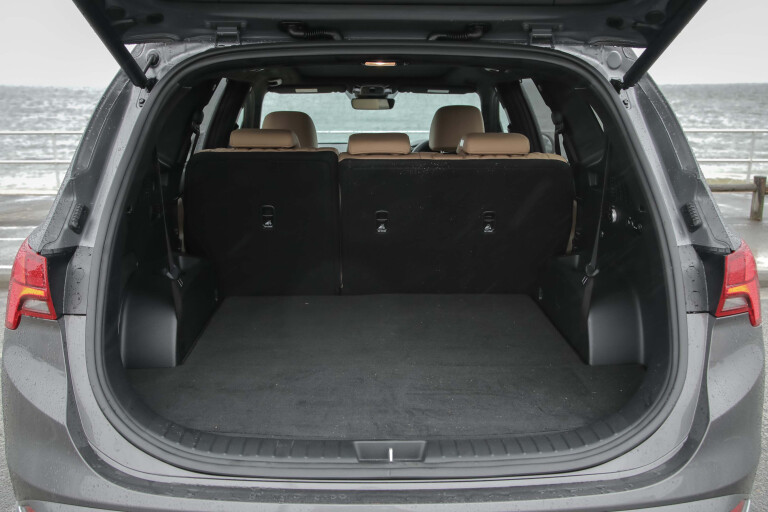
On the road
As with the MY21 and as it has been since the facelift, the Santa Fe has definitely skewed towards comfort. The 2018 original was obscenely good fun for such a big unit and we can thank our local friendly Hyundai handling team for that. It was, however, on the firm side.
So the team set to work and wound things back a little, delivering a much more comfortable ride while knocking the sharp edges off without sacrificing too much of the fun. The result is a superb ride that makes a trip of any length a genuine pleasure.
The steering remains the right weight and speed, no matter which of the (road-biased) modes you choose. I don’t know about the off-road modes because at the moment, anything off-road near Sydney is a lake. The body does move around a little more than the 2018 car, too, but it’s nothing unpleasant or unsettling for driver or passenger.
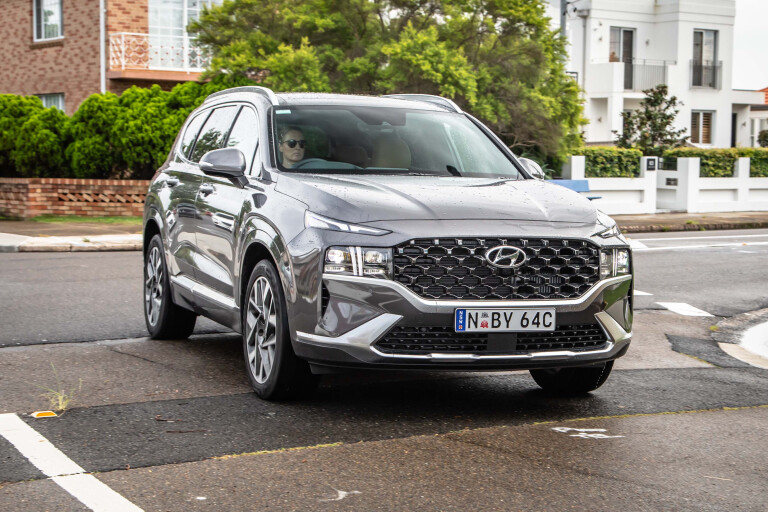
As with any large Hyundai, it’s the diesel that’s the best, the 2.2-litre four-cylinder turbo unit delivering 148kW at 3800rpm and 440Nm from a low 1750rpm before tapping out at 2750rpm.
The diesel is supported by the company’s own eight-speed dual-clutch transmission. It’s a belter of a gearbox and I wish it would find its way into the turbo-powered Tucson and i30 models (non-N versions, anyway) because it’s a pleasure to have it on board. Quick shifting and with the feel of a torque converter in almost every situation, it’s really excellent.
It’s not long now until we’ll see whether the diesel will be challenged by the hybrid, which will be cleaner in all kinds of ways. The diesel engine is torquey and once warm you’ll barely even know it's there.
I picked up some people who hadn’t been in a Hyundai for some years and they were amazed at how quiet and comfortable they found the car as I acted as an impromptu Uber driver on a taxi-deficient wet Thursday morning.
Against Hyundai’s official 6.1L/100km fuel figure I got 8.2L/100km in a reasonably balanced city/highway split, which is not bad going for such a big chunky machine.

Ownership
Hyundai's pace-setting five-year, unlimited-kilometre warranty does fall short of compatriot Kia’s seven years and is now the standard for most manufacturers.
Servicing costs no more than $459 per service for the first five years and you have to return to the dealer every 12 months or 15,000km.
Hyundai’s lifetime capped-price servicing scheme publishes costs out to a ridiculous 34 years or 510,000km and none of the services seem alarmingly expensive, which is comforting for your kids if they inherit the car upon your death.
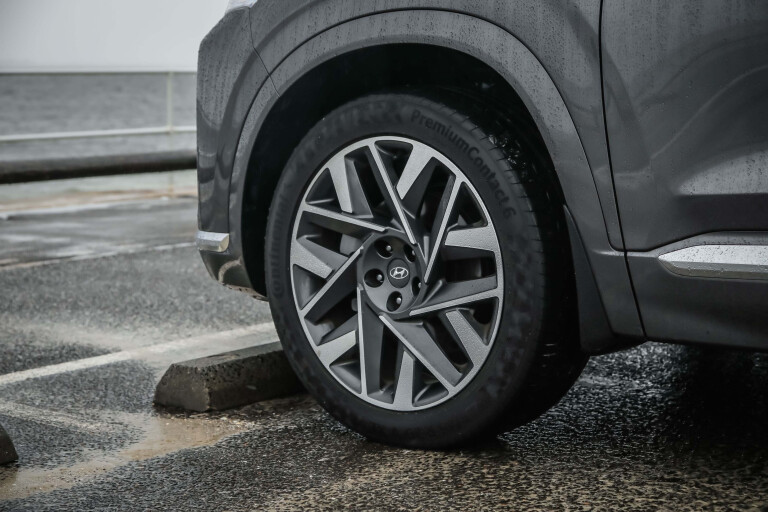
VERDICT
Will the diesel be able to hold its own against the incoming hybrid? With an expected price gap of several thousand dollars, that’s going to be time to bust out the calculator, an easier task when fuel is so colossally expensive.
Safety upgrades to the MY22 range are also very handy additions for a fairly modest increase in price. It’s interesting to note that these additions have come when the global industry is in a very tight spot for parts, but Hyundai seems to have avoided the worst of it and not had to remove features – at least not on the Highlander.
The Santa Fe remains high on my list of SUVs to recommend, but the clock really is ticking for the diesel. The conundrum here is, of course, that the petrol V6 is also quite thirsty and front-wheel-drive only.
I’m hoping Hyundai is just sweating these ICE-y assets as long as they can until the company can go all-in on electric.
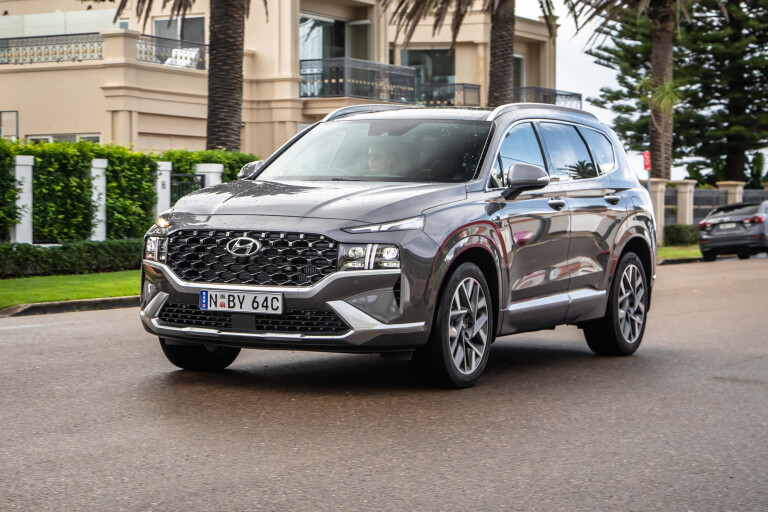
2022 Hyundai Santa Fe Highlander specifications
| Body: | 5-door, 7-seat large SUV |
|---|---|
| Drive: | all-wheel |
| Engine: | 2.2-litre 4-cylinder turbo-diesel |
| Transmission: | 8-speed dual-clutch |
| Power: | 148kW @ 3800rpm |
| Torque: | 440Nm @ 1750-2750rpm |
| Bore stroke (mm): | 83 x 99.4 |
| Compression ratio: | 16.0 : 1.0 |
| 0-100km/h: | 9.0 sec (estimate) |
| Fuel consumption: | 6.1L/100km (combined) |
| Weight: | 1943kg |
| Suspension: | MacPherson struts front / multi-link rear |
| L/W/H: | 4785mm/1900mm/1710mm |
| Wheelbase: | 2765mm |
| Brakes: | 325mm ventilated disc front / 305mm solid disc rear |
| Tyres: | 255/45 R20 |
| Wheels: | 20-inch alloy (full-size alloy spare) |
| Price: | $66,050 + on-road costs |
Score breakdown
Things we like
- Excellent driveline
- Loaded with tech and gear
- Much better than the petrol
- So comfortable
Not so much
- Hybrid option might be better
- Tight third row
- No wireless Apple CarPlay
- Curtain airbags don’t reach third row



COMMENTS